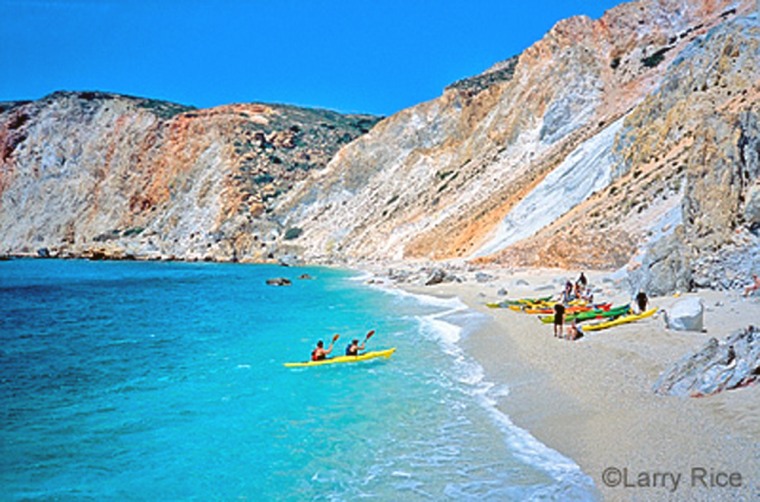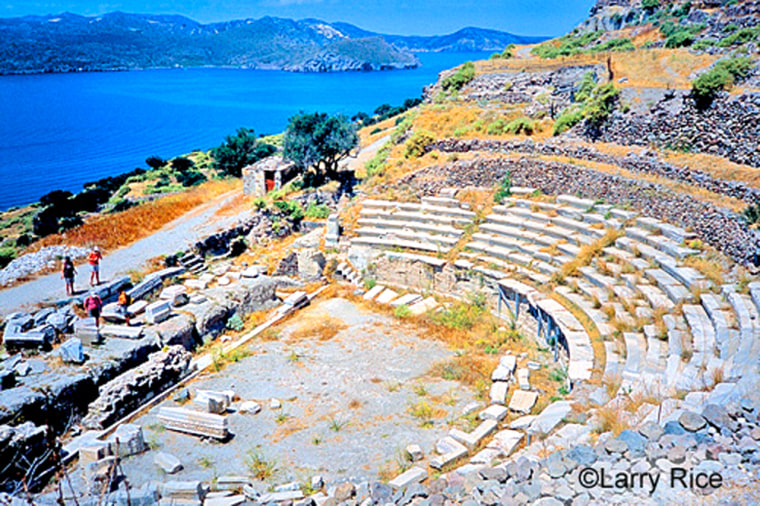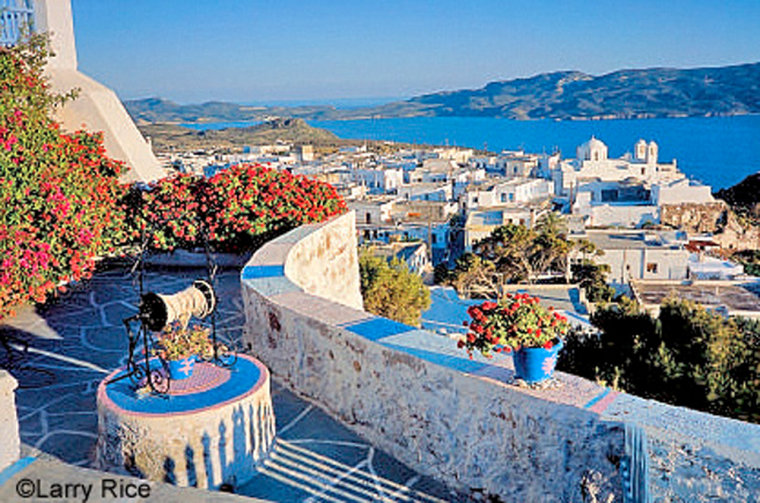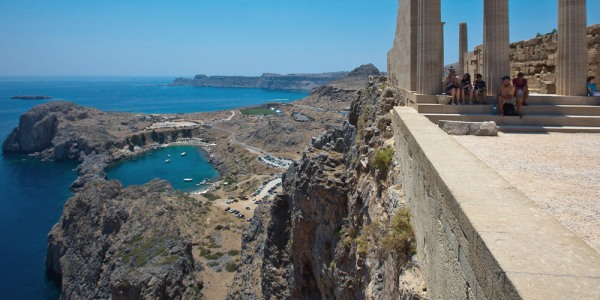Backpaddling into a phosphorescence-tinted sea cave is just the beginning of the otherworldly experiences in Greece.
Paddling tandem through the deep blue Mediterranean swells, relaxed and in sync, my partner, Mara, and I abruptly spot a large reptilian shape floating near the surface. “Turtle! Turtle!” we shout together as the stealth figure dives. At the same time, a chorus of “Capsize! Capsize!” rises from the gaggle of sea kayaks 50 yards behind us. In the ensuing commotion, our leader, Rod Feldtmann, doesn’t know where to look first.
“They’ll sort themselves out,” Rod says cheerfully, glancing back at the three Brits who’ve surrounded their boatless buddy, an experienced kayaker who’s laughing at his own unexpected swim. “Now where was it you saw that turtle?” he wants to know as we continue our journey just offshore from the Greek island of Milos, a volcanic wonderland 100 miles south of Athens in the brilliantly clear Aegean Sea.
As we round the first headland, spectacular offshore rock formations begin to appear—grand arches, enticing tunnels, majestic spires—and such an abundance of alluring sea caves that we lose count
Tanned, blue-eyed, and always barefoot, Rod looks about as Greek as Russell Crowe, with a Down Under accent to match. Raised in southeast Australia, he arrived on Milos in 1996, worked as an exploration geologist, fell in love with a Greek woman, met her extensive family, and got married in the local church. (“Ever see My Big Fat Greek Wedding?” he loves to ask. “Well, it was exactly like that. Even crazier—her parents didn’t know English and I didn’t know Greek.”) About the same time that he started his own family with his wife, Petrinela, he launched Sea Kayak Milos, one of only two sea-paddling operations based in Greece.
That’s not a whole lot of competition for the 1,400-odd islands of the Greek archipelago, and on this golden, sun-drenched morning we feel like we have the entire Mediterranean to ourselves.
Three million years of volcanic activity have created this horseshoe-shaped island, 60 square miles of soaring cliffs, secluded beaches, and miniature offshore islands virtually untouched by the rampant tourism that blights some of the other Greek islands.

As we round the first headland, spectacular offshore rock formations begin to appear—grand arches, enticing tunnels, majestic spires—and such an abundance of alluring sea caves that we lose count. The first is so narrow that we wonder how we’ll get out, even if we all do manage to fit in. So Rod has us backpaddle in one at a time, seven solos and two tandems. Any initial claustrophobia quickly dissolves as we move deeper into one of the blue caves of Milos, so named because of the uncanny, luminous, almost neon blue light that permeates its otherwise inky interior. Even our gently rocking boats and slow-motion paddles seem to glow in the phosphorescent light. The effect is supernatural, almost mystical, and once we’re all inside, no one speaks. As we paddle out, I can’t help thinking, it’s only our first hour on the water. What could top this?
Slideshow 23 photos
A European tour
Well, how about a sea cave so extravagant that in all my worldwide paddles, from the Arctic to Antarctica, I’ve never seen anything like it. A behemoth chamber 200 feet deep by 50 feet high is big enough that it could easily hold 100 kayaks and still seem spacious. Feeling puny, we bounce around in the darkness and gawk, mesmerized by the reflections of sea light on its Jackson Pollock ceiling: gorgeous mineralized splatters of deep purple, seaweed green, and sulfur yellow streaking down the rough-textured walls. Just as hypnotic is the eerie music of the active ocean—a low groaning, sucking sound—swishing in and out of the archlike portal.
Again I remind myself that our otherworldly experiences have just begun. We continue east along the northern coast and discover the almost-lunar landscape of Sarakiniko Beach, a sublime cove of calm turquoise sea surrounded not by sand but by mounds and sinkholes of pure white pumice rock, smooth enough for sunbathing.
Looming just a few hundred yards away is an imposing shipwreck, a huge freighter, sunk in a ferocious storm just 18 months before. It lies split in two before us, cracked open violently on the rocks. We notice that even the wooden lifeboat, still hoisted on its ropes and hanging in shreds, is severed in two. But it’s the colors of rusting, peeling paint that fascinate; royal blues, blazing yellows, and burnished russets glitter in the midday sun as we paddle around and through the ravaged ship.
Pushing northeast, we pull in for lunch at small, pretty Agios Konstantinos beach. Our European companions are blasé, but being raised on modesty in the Midwest, I can’t help but act goofy about the bevy of topless, goddesslike women sunbathing just yards away. Mara notices my slack-mouthed behavior and rolls her eyes. “Give it a break!” she admonishes as she dives into the cool, swim-perfect waters, and is soon joined by the others in our party.
Refreshed by swim, snorkel, and sun, we gather in a dry cave, looking out at the impossibly clear azure water. Rod and his young summer assistant, New Zealander Paul Pringle, have been busy improvising table and chairs from flat stones and smooth driftwood planks. As we hunker down to a feast of fresh Milos bread, local vegetables, fish, feta, melon, and buttery biscuits, I’m just about certain we’re all having the same thought: there’s no place on this sweet, sea-lapped earth I’d rather be.
From our cool, shallow cavern, we gaze out curiously at this afternoon’s destination: the two uninhabited islands of Glaronisia, jutting out of the sea due north. As we suit up for the voyage, Rod reminds the group that we’ll be quartering against a strong southwest wind, and less than an hour later we approach the larger of the rocky islets in three-foot swells. The adrenaline is pumping for the novices as we maneuver through cathedral-size arches where, due to an optical illusion, the sea seems to be rushing downhill. Even the veterans among us can’t help but be overwhelmed by the strange, dark beauty of Glaronissia, whose fantastic columns of basaltic rock soar skyward, looking like a million ragged organ pipes turned to stone.
We take refuge from the wind and waves on the island’s leeward side, ooohs and ahhhs all around, before bounding back into the open sea. But the wind has picked up to a force 4, building toward whitecaps and bigger waves, and Rod wisely alters our return route so we won’t be bucking a headwind. Even so, we plunge through a rollicking fun roller coaster of nearly four-foot swells, an exhilarating spray in our faces, watching the joy jump into our leader’s eyes. “Now this is sea kayaking!” Rod shouts, his whole body one smooth, graceful paddling machine, as our gleeful band of nine boats works its way home, sideways to the lowering sun.
Our eight days on Milos unfold like a seafarer’s dream. Each morning blossoms bright and sunny as we gather for breakfast in the family-owned café just below our comfortable rooms. Each day, depending on wind conditions, we explore a different section of the jagged coastline or paddle to nearby islands with mythical names like Arcadia and Kimolos. Beneath 600-foot-high multicolored cliffs, we float and dive off sunbaked rocks. On the starkly beautiful islet of Efstathios, we climb an abandoned lighthouse and run with the wild goats. We practice our rolls, search abandoned sulfur mines, and crawl on hands and knees through alarmingly tight sea tunnels, waves lapping our chests, emerging into secret under-island caverns.

We end most days with a hearty round of Mythos beer in a beachside café before we’re shuttled back through the terraced countryside to our base village of Triovasalos, past olive groves, grazing sheep, and 2,000-year-old stone walls. Each night we wander the winding cobblestone streets of whitewashed villages, explore Hellenistic ruins, and sample excellent food like lythrini and spanakopita, washed down by local red wine.
It’s not until our final afternoon that I notice two large words plastered on the back of Rod’s 4x4 Suzuki and fairly dancing in the golden light: MAGIC HAPPENS. I don’t need convincing. The ancient landscape of Milos, its brilliant colors, welcoming people, and ever-present blue Aegean Sea have worked their magic on us all. Right now, in fact, the only thought in my entire sun-tinged, happy brain is why it took me so long to paddle and play in the fabled Greek isles.
Larry Rice is a contributing editor for Canoe & Kayak. Widely traveled, he reports that Greece is now among his five favorite countries in the world.
TRIP DETAILS
Getting There: Olympic Airways flies daily nonstop to Athens from JFK and Montreal. Upon arrival, board an express bus to Syntagma, the city’s main hub, packed with restaurants, shops, and hotels for every budget. The best time to visit is spring and fall—the weather’s perfect and the crowds haven’t yet arrived.
Scattered throughout the Aegean and Ionian Seas, arms of the Mediterranean, the Greek islands number over 1,400, but only about 170 are inhabited. The rest beg to be explored. Guided circumnavigation of one or more islands is ideal for novice paddlers, while island hopping is recommended for accomplished kayakers only.
Sea Kayak Milos, www.seakayakgreece.com, offers full-day to weeklong guided trips, mid-March to mid-October, for beginning and experienced paddlers. Its most popular package, Explore Milos, includes eight nights at a B&B, six guided day trips, and all equipment (450 euros or about $600 per person/double). Overnight trips plus island-to-island expeditions for advanced paddlers are also available.
Around Athens: Plan to spend a few days in the birthplace of Western civilization before heading to the quieter islands. On your must-do list: climb to the hilltop Acropolis and its crowning jewel, the Parthenon; visit the Ancient Agora, with its temples, altars, and tombs; hike up Lykavittos, the Hill of Wolves, for a sprawling view of modern Athens; and sip thick Greek coffee out of tiny cups in the ubiquitous sidewalk cafés.
Heading Out to the Islands: Milos is located in the Cyclades group of islands in the Aegean Sea, about halfway between Athens and the island of Crete. Olympic Airways offers a daily 30-minute flight, or catch a ferry or high-speed catamaran from the port of Piraeus, just a few miles from Athens. Tourism on Milos remains relatively light, making for an authentic Greek experience. From here you can island-hop all over the Aegean Sea, with ferry connections to various ports, including Paros, Santorini, Crete, and Rhodes.
is the number one paddlesports resource, with a wealth of information about canoeing and kayaking destinations, gear, and techniques.

